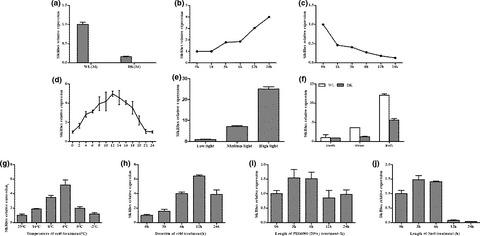当前位置:
X-MOL 学术
›
Food Sci. Nutr.
›
论文详情
Our official English website, www.x-mol.net, welcomes your
feedback! (Note: you will need to create a separate account there.)
Overexpression of SikRbcs2 gene promotes chilling tolerance of tomato by improving photosynthetic enzyme activity, reducing oxidative damage, and stabilizing cell membrane structure.
Food Science & Nutrition ( IF 3.5 ) Pub Date : 2020-05-25 , DOI: 10.1002/fsn3.1631 Li Zhang 1 , Jing Yang 2 , Xinyong Guo 1 , Aiying Wang 1 , Jianbo Zhu 1
Food Science & Nutrition ( IF 3.5 ) Pub Date : 2020-05-25 , DOI: 10.1002/fsn3.1631 Li Zhang 1 , Jing Yang 2 , Xinyong Guo 1 , Aiying Wang 1 , Jianbo Zhu 1
Affiliation

|
Red blood cell is a small subunit encoding 1, 5‐ribulose bisphosphate carboxylase/ oxygenase (Rubisco). It could control the catalytic activity of Rubisco and play an important role in plant photosynthesis. SikRbcs2, a small subunit of Rubisco, is cloned from Saussurea involucrate. It has a strong low‐temperature photosynthetic and photorespiration ability, but its mechanism in cold tolerance remains to be unknown. The results of quantitative PCR showed that SikRbcS2 gene could be induced by low‐temperature, osmosis, and salt stress. Its expression was increased with the decrease of temperature, which was consistent with the habitat of Saussurea involucrata. Overexpression of Sikrbcs2 could significantly increase the mRNA expressions of SlrbcL and SlRCA in transgenic tomato seedlings. Furthermore, the activity and content of Rubisco and Rubisco activase (RCA) in transgenic tomato seedlings were also significantly higher than those in wild‐type plants. The contents of chlorophyll and carotenoids, soluble sugar, and starch in the leaves of transgenic plants were significantly higher than those in WT plants, as well as the plant height, leaf area, and dry matter weight. Moreover, compared with WT, MDA content was decreased, and activities of SOD, POD, CAT, and APX were significantly higher in transgenic lines. In conclusion, our results suggested that overexpression of SikRbcs2 can reduce the damage of low temperature on photosynthesis of tomato seedlings. It could help achieve relatively stable photosynthesis, enhance scavenging ROS ability of tomato seedlings, maintain stable membrane structure, and improve cold tolerance of tomato.
中文翻译:

SikRbcs2基因的过表达通过提高光合酶活性、减少氧化损伤、稳定细胞膜结构来促进番茄的耐冷性。
红细胞是编码 1, 5-核酮糖二磷酸羧化酶/加氧酶 (Rubisco) 的小亚基。它可以控制Rubisco的催化活性,在植物光合作用中发挥重要作用。 SikRbcs2是 Rubisco 的一个小亚基,是从Saussurea involucrate中克隆的。它具有较强的低温光合和光呼吸能力,但其耐冷机制尚不清楚。定量PCR结果表明SikRbcS2基因可被低温、渗透和盐胁迫诱导。其表达量随着温度的降低而增加,这与雪莲的生境相符。过表达Sikrbcs2可以显着增加转基因番茄幼苗中SlrbcL和SlRCA mRNA的表达。此外,转基因番茄幼苗中Rubisco和Rubisco激活酶(RCA)的活性和含量也显着高于野生型植物。转基因植株叶片中叶绿素、类胡萝卜素、可溶性糖、淀粉含量均显着高于野生型植株,株高、叶面积、干物质重也显着高于野生型植株。此外,与WT相比,转基因株系中MDA含量降低,SOD、POD、CAT、APX活性显着升高。总之,我们的结果表明SikRbcs2的过表达可以减少低温对番茄幼苗光合作用的损害。有助于实现相对稳定的光合作用,增强番茄幼苗清除ROS的能力,维持稳定的膜结构,提高番茄的耐寒性。
更新日期:2020-05-25
中文翻译:

SikRbcs2基因的过表达通过提高光合酶活性、减少氧化损伤、稳定细胞膜结构来促进番茄的耐冷性。
红细胞是编码 1, 5-核酮糖二磷酸羧化酶/加氧酶 (Rubisco) 的小亚基。它可以控制Rubisco的催化活性,在植物光合作用中发挥重要作用。 SikRbcs2是 Rubisco 的一个小亚基,是从Saussurea involucrate中克隆的。它具有较强的低温光合和光呼吸能力,但其耐冷机制尚不清楚。定量PCR结果表明SikRbcS2基因可被低温、渗透和盐胁迫诱导。其表达量随着温度的降低而增加,这与雪莲的生境相符。过表达Sikrbcs2可以显着增加转基因番茄幼苗中SlrbcL和SlRCA mRNA的表达。此外,转基因番茄幼苗中Rubisco和Rubisco激活酶(RCA)的活性和含量也显着高于野生型植物。转基因植株叶片中叶绿素、类胡萝卜素、可溶性糖、淀粉含量均显着高于野生型植株,株高、叶面积、干物质重也显着高于野生型植株。此外,与WT相比,转基因株系中MDA含量降低,SOD、POD、CAT、APX活性显着升高。总之,我们的结果表明SikRbcs2的过表达可以减少低温对番茄幼苗光合作用的损害。有助于实现相对稳定的光合作用,增强番茄幼苗清除ROS的能力,维持稳定的膜结构,提高番茄的耐寒性。











































 京公网安备 11010802027423号
京公网安备 11010802027423号